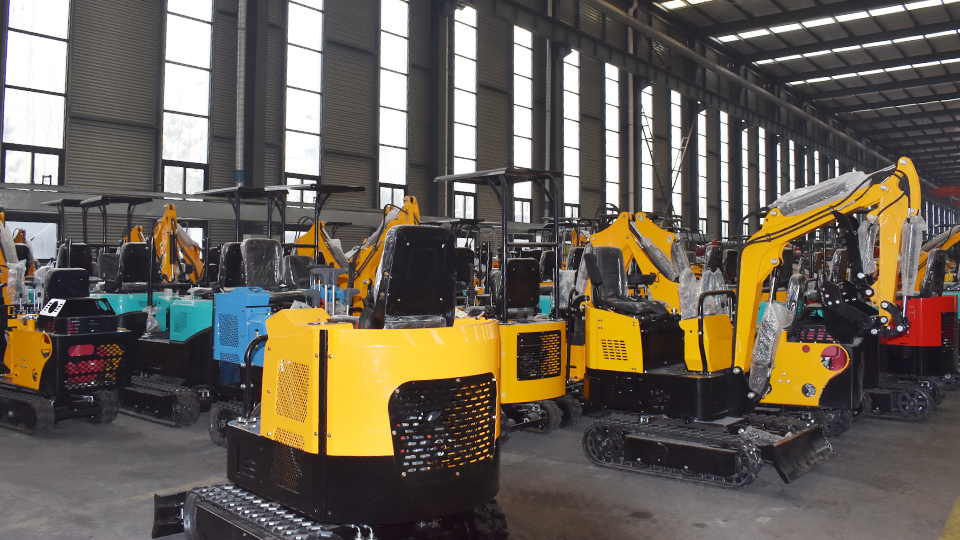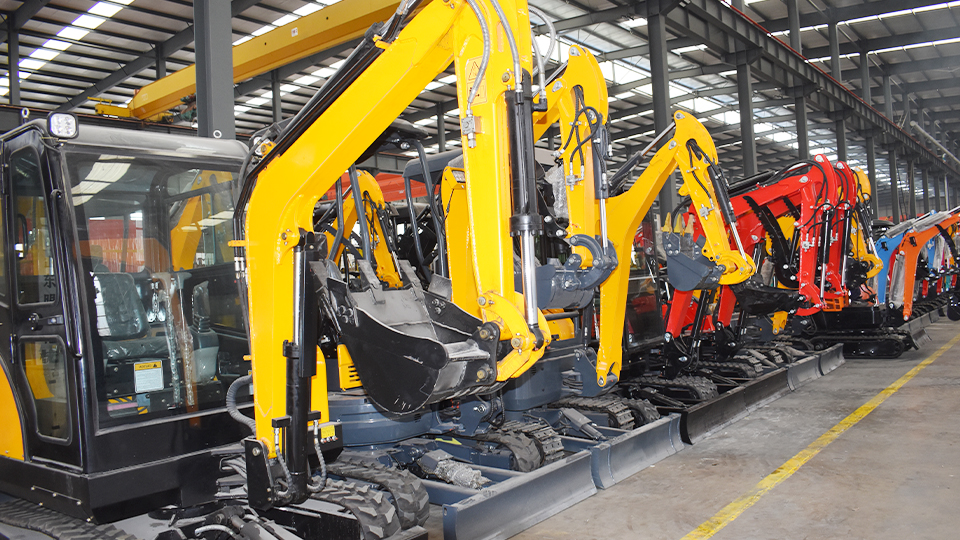1. The Persistent Challenge of Excavator Safety
Excavators operate in dynamic, often unpredictable environments. The primary risks stem from several factors:
Limited Visibility: Blind spots around the machine are a major contributor to collisions with personnel, other equipment, or objects.
Striking Underground Utilities: Damaging gas lines, electrical cables, or water pipes can lead to explosions, electrocution, or service disruptions.
Trench Collapse: Unstable soil conditions and improper shoring can result in life-threatening trench collapses.
Rollovers: Operating on uneven terrain, exceeding load limits, or improper maneuvering can cause the excavator to tip over.
Falling Objects: Loads can shift or detach, posing a hazard to ground personnel.
Operator Fatigue and Distraction: Extended shifts, repetitive tasks, and external factors can impair an operator's judgment and reaction time.
Human Error: Despite training, mistakes happen, especially under pressure or in complex situations.
Traditional safety measures, while vital, often rely on human vigilance and adherence to protocols. Technology aims to augment human capabilities, provide real-time alerts, and even autonomously intervene to prevent incidents.
2. Enhancing Situational Awareness: Vision and Proximity Systems
One of the most critical areas for technological intervention is improving the operator's understanding of their surroundings.
360-Degree Camera Systems:
How it Works: Multiple wide-angle cameras strategically placed around the excavator capture real-time video feeds. These feeds are then stitched together by software to create a seamless, bird's-eye view of the machine's surroundings, displayed on an in-cab monitor. Some systems can also overlay distance markers or projected paths.
Safety Enhancement: Eliminates blind spots, providing operators with a comprehensive view of personnel, obstacles, and other equipment near the machine, significantly reducing the risk of collisions during swinging, traveling, and digging.
Examples: Volvo's Smart View, Komatsu's KomVision, Caterpillar's Cat Detect with object detection.
Radar and Lidar-Based Proximity Detection Systems:
How it Works: These systems use radar (radio waves) or lidar (laser light) to detect objects or personnel within a predefined zone around the excavator. When an object enters the warning zone, the operator receives audible and visual alerts. Some advanced systems can differentiate between humans and inanimate objects.
Safety Enhancement: Provides an extra layer of protection, particularly in dusty, foggy, or low-light conditions where camera visibility might be compromised. Offers precise distance measurements and can even track movement.
Integration: Often integrated with camera systems for a combined sensory input.
Ultrasonic Sensors:
How it Works: Similar to parking sensors on cars, these emit ultrasonic waves and detect echoes to measure distances to nearby objects.
Safety Enhancement: Useful for close-quarter maneuvers, providing warnings for obstacles directly in the path of the swing or movement.
Personnel Detection Systems (Wearable Technology Integration):
How it Works: Workers on foot wear active tags (e.g., RFID, UWB - Ultra-Wideband) that communicate with receivers on the excavator. When a tagged worker enters a pre-set exclusion zone, both the worker's tag and the excavator's in-cab system alert the respective individuals.
Safety Enhancement: Provides direct warnings to both the operator and the pedestrian, significantly reducing the risk of struck-by incidents in busy work zones. This is particularly effective where visibility is consistently challenged.
3. Preventing Collisions and Overloading: Machine Control and Warning Systems
Beyond mere awareness, technology is enabling excavators to actively help prevent accidents.

Collision Avoidance Systems:
How it Works: Integrating data from GPS, sensors, and machine control systems, these systems define "no-go" zones or critical clearances. If a part of the excavator (e.g., boom, stick, bucket) approaches a defined limit (e.g., overhead power lines, existing structures, another machine), the system provides warnings and can even automatically slow down or stop machine movement.
Safety Enhancement: Prevents contact with overhead obstructions, adjacent structures, or other equipment, crucial for working in confined spaces or near valuable assets.
Overload Warning Systems / Load Moment Indicators (LMIs):
How it Works: Sensors measure the weight of the load, boom angle, and reach. This data is fed into a computer that compares it against the excavator's rated load chart. If the load approaches or exceeds the safe working limit, the system alerts the operator with visual and audible warnings. Some systems can also inhibit further lifting or extending movements.
Safety Enhancement: Prevents rollovers due to overloading and ensures the structural integrity of the machine, crucial when lifting heavy pipes, concrete slabs, or other materials.
Slope and Grade Control Systems:
How it Works: Using GPS, tilt sensors, and sometimes laser receivers, these systems provide real-time feedback on the bucket's position relative to the desired grade or slope.
Safety Enhancement: While primarily for efficiency, precise grade control reduces the need for ground personnel in dangerous excavation zones, preventing trench collapses caused by over-excavation and ensuring stability when digging on slopes. It minimizes the need for manual checks in the trench, reducing worker exposure.
Dig Assist / Utility Avoidance Systems:
How it Works: Integrates with 3D site models and utility maps. As the excavator digs, the system displays the location of known underground utilities on the in-cab display. It can provide warnings when the bucket approaches a utility line, and some advanced systems can even create virtual "no-dig" zones.
Safety Enhancement: Significantly reduces the risk of striking buried utilities, preventing costly damage, service interruptions, and potentially catastrophic accidents (e.g., gas explosions, electrocution). This technology complements "Call Before You Dig" protocols.
4. Data-Driven Safety: Telematics and Fleet Management
Telematics systems, initially developed for productivity monitoring, are now powerful tools for enhancing safety.
Real-time Data Collection: Telematics units collect vast amounts of data, including machine location, operating hours, fuel consumption, idle time, engine parameters, fault codes, and operator performance metrics (e.g., hard braking, rapid acceleration, excessive swings).
Geofencing:
How it Works: Defines virtual boundaries for the excavator's operation. If the machine leaves or enters a specific area, alerts are triggered.
Safety Enhancement: Prevents unauthorized use, keeps machines within safe work zones, and can notify supervisors if an excavator enters a designated "no-go" area or a hazardous zone (e.g., near an active pipeline).
Remote Diagnostics and Predictive Maintenance:
How it Works: Fault codes and performance data are transmitted wirelessly, allowing technicians to remotely diagnose issues. Predictive analytics can identify potential component failures before they occur.
Safety Enhancement: Proactive maintenance prevents mechanical failures (e.g., hydraulic line bursts, brake failure) that could lead to accidents. It ensures machines are operating in optimal and safe condition.
Operator Performance Monitoring:
How it Works: Tracks operator habits that could impact safety (e.g., sudden movements, operating outside set parameters, excessive machine stress).
Safety Enhancement: Identifies operators who may need additional training or coaching to improve safe operating practices. It can also identify machines being operated inappropriately.
Automated Reporting and Compliance:
How it Works: Telematics systems can automatically generate reports on machine usage, safety alerts, and maintenance logs.
Safety Enhancement: Provides documentation for regulatory compliance and helps identify trends in unsafe operations across a fleet, enabling targeted safety interventions.
5. Mitigating Human Factors: Operator Assistance and Fatigue Management
Technology is also addressing the human element of safety.
Operator Fatigue Monitoring Systems:
How it Works: In-cab cameras and sensors monitor operator behavior, looking for signs of drowsiness (e.g., yawning, eye closure patterns, head nodding). Some systems also track operator heart rate or brainwave activity via wearable sensors.
Safety Enhancement: Provides real-time alerts to the operator and/or supervisors, prompting breaks or intervention before fatigue leads to critical errors.
Intuitive Controls and Human-Machine Interface (HMI):
How it Works: Modern excavators feature highly ergonomic joysticks, configurable controls, and large, clear touchscreens that display critical information concisely.
Safety Enhancement: Reduces operator fatigue and cognitive load, allowing them to focus more on the task and less on wrestling with complex controls. Clear displays minimize distractions and ensure vital safety information is readily accessible.
Virtual Reality (VR) and Augmented Reality (AR) Training:
How it Works: VR simulators immerse operators in realistic, interactive virtual construction sites, allowing them to practice complex maneuvers, emergency procedures, and hazard recognition in a safe, risk-free environment. AR can overlay digital information onto the real-world view during training or operation.
Safety Enhancement: Provides extensive practice for emergency scenarios (e.g., rollover recovery, hydraulic failure) that are too dangerous to replicate in real life. It also allows new operators to develop muscle memory and situational awareness before stepping into a real machine, drastically reducing initial training risks.
6. The Horizon of Automation: Remote Control and Autonomy
The ultimate technological leap for safety lies in removing operators from immediate harm's way or enabling machines to operate with increased precision.
Remote Control Excavators:
How it Works: Operators control the excavator from a safe distance using a remote console with joysticks and monitors.
Safety Enhancement: Ideal for extremely hazardous environments where human presence is too risky (e.g., unstable ground, demolition of dangerous structures, hazardous material handling, working under high-voltage lines, or in extremely hot/cold conditions). It completely removes the operator from immediate physical danger.
Semi-Autonomous and Fully Autonomous Excavators:
How it Works: Semi-autonomous systems assist operators with repetitive tasks (e.g., automated digging cycles, auto-leveling). Fully autonomous excavators can perform tasks independently based on pre-programmed designs and real-time sensor data, with human oversight.
Safety Enhancement: Eliminates human error in repetitive or predictable tasks, leading to higher precision and consistency. In the long term, autonomous systems could drastically reduce accidents by optimizing paths, detecting obstacles, and adhering strictly to safety parameters without fatigue or distraction. While still in early adoption for full autonomy on construction sites, the trajectory is clear.
Conclusion: A Safer Future for Excavation
The integration of advanced technologies is fundamentally reshaping excavator safety. From comprehensive vision systems that eliminate blind spots to intelligent machine control that prevents collisions and overloading, and data-driven telematics that enable proactive maintenance and operator coaching, the modern excavator is a testament to the power of innovation in risk mitigation.

While technology offers unprecedented opportunities to enhance safety, it is crucial to remember that it is a tool to augment, not replace, human judgment and rigorous safety protocols. Comprehensive operator training remains paramount, focusing on not just how to operate the machine, but also how to interpret and utilize the vast amount of data and warnings provided by these advanced systems.
As the construction industry continues to embrace digitalization and automation, the role of technology in ensuring excavator safety will only grow. The ultimate goal is to create a work environment where the immense power of these machines can be harnessed with minimal risk, safeguarding lives, protecting assets, and enabling projects to proceed with unparalleled efficiency and confidence. The future of excavation is not just smarter and more productive, but profoundly safer.
Post time:Sep-25-2020
